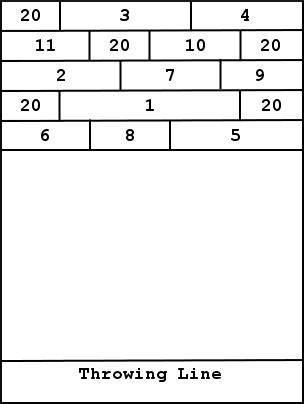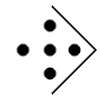Brother Jonathan was invented in North America during the 1700s (Diagram Group 128). Originally, the players tossed copper pennies at the board (Bell, Board and Table Games 132). You can use whatever coins or coin-like tokens you find most handy.
Brother Jonathan
The rules for this game come from The Way to Play by the Diagram Group, p. 128, with additional information from Board and Table Games from Many Civilizations by R.C. Bell, pp. 131-132. The numbering for the board that I used is from Board and Table Games from Many Civilizations. The board shown in The Way to Play is nearly identical except that the 6 in the first row is replaced with a 7. The numbers in Bell's book made more sense to me because the board contains the numbers 1 through 11 (in random order) with 20 in a few places to give the players something higher to aim for. The lines for the two boards are also nearly identical, although they made a couple of the boxes a little different size. My lines are closer to the ones in The Way to Play because they looked better to me, easier to keep the boxes in proportion. You can mark your board as you wish.
I don't provide a printable board for this game because it would have to be bigger than standard 8.5 by 11 inch paper. (I couldn't find specific dimensions for the board, but it should be large enough for the coins or tokens used and for the numbers to be easily seen from whatever distance the players stand from the board.)
Players: 2 or more, can be played as a team game
Object: To earn more points than the other players by tossing coins on the board.

Equipment: Some coins (Or small coin-sized discs, like poker chips, if you don't want to use real money. According to Bell, they typically used five coins at a time (p. 132)), chalk to draw the board on the ground or a large piece of paper to draw the board for the indoor game.
Set Up: To set up the game, draw the diagram for the board (as shown) on the ground or on a large piece of paper. The board is the section at the top of the diagram that contains the small boxes with point values. (If you're drawing the board yourself on another large sheet of paper, you only need to draw the section with the point values. I just drew the whole diagram so that you would see the relationship of the board to the the line where players stand.)
The boxes are different sizes and are worth different point values. The smallest boxes have higher point values than the larger ones.
Before the players begin playing, they should decide how they will determine the winner. There are two ways to do that, shown below.
Playing: Choose a spot for the players to stand (such as behind the line drawn across the bottom of the diagram). The players take turns standing in that spot and tossing a coin onto the board. The players earn points according to the value on the section where each coin lands. If a coin lands on or touching one of the lines, the player doesn't earn any points.
Winning: There are two ways to determine the winner:
- The players can pick a target number of points (ex. 100 points or 200 points total). The first person to reach the target number wins.
- The players decide on a certain number of throws each person is allowed to make (ex. Five or ten tosses each). The person with the most points at the end of the throws wins.
Wall Jonathan:This is a variation on the basic Brother Jonathan game. The only difference is that the players don't toss their coins directly onto the board; they toss them against a wall so that they bounce back onto the board. Otherwise, the game is the same.

